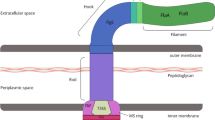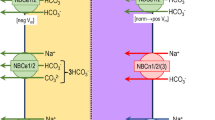Abstract
Urea transporters in bacteria are relatively rare. There are three classes, the ABC transporters such as those expressed by cyanobacteria and Corynebacterium glutamicum, the Yut protein expressed by Yersinia spp and the UreI expressed by gastric Helicobacter spp. This review focuses largely on the UreI proton-gated channel that is part of the acid acclimation mechanism essential for gastric colonization by the latter. UreI is a six-transmembrane polytopic integral membrane protein, N and C termini periplasmic, and is expressed in all gastric Helicobacter spp that have been studied but also in Helicobacter hepaticus and Streptococcus salivarius. The first two are proton-gated, the latter is pH insensitive. Site-directed mutagenesis and chimeric constructs have identified histidines and dicarboxylic amino acids in the second periplasmic loop of H. pylori and the first loop of H. hepaticus UreI and the C terminus of both as involved in a hydrogen-bonding dependence of proton gating, with the membrane domain in these but not in the UreI of S. salivarius responding to the periplasmic conformational changes. UreI and urease are essential for gastric colonization and urease associates with UreI during acid exposure, facilitating activation of the UreA and UreB apoenzyme complex by Ni2+ insertion by the UreF-UreH and UreE-UreG assembly proteins. Transcriptome analysis of acid responses of H. pylori also identified a cytoplasmic and periplasmic carbonic anhydrase as responding specifically to changes in periplasmic pH and these have been shown to be essential also for acid acclimation. The finding also of upregulation of the two-component histidine kinase HP0165 and its response element HP0166, illustrates the complexity of the acid acclimation processes involved in gastric colonization by this pathogen.



Similar content being viewed by others
References
Andrutis K.A., Fox J.G., Schauer D.B., Marini R.P., Murphy J.C., Yan L., Solnik J. 1995. Inability of an isogenic urease-negative mutant stain of Helicobacter mustelae to colonize the ferret stomach. Infect. Immun. 63:3722–3725
Athmann C., Zeng N., Kang T., Marcus E.A., Scott D.R., Rektorschek M., Buhmann A., Melchers K., Sachs G. 2000. Local pH elevation mediated by the intrabacterial urease of Helicobacter pylori cocultured with gastric cells. J. Clin. Invest. 106:339–347
Beckers G., Bendt A.K., Kramer R., Burkovski A. 2004. Molecular identification of the urea uptake system and transcriptional analysis of urea transporter- and urease-encoding genes in Corynebacterium glutamicum. J. Bacteriol. 186:7645–7652
Brayman T.G., Hausinger R.P. 1996. Purification, characterization, and functional analysis of a truncated Klebsiella aerogenes UreE urease accessory protein lacking the histidine-rich carboxyl terminus. J. Bacteriol. 178:5410–5416
Bury-Mone S., Skouloubris S., Labigne A., De Reuse H. 2001. The Helicobacter pylori UreI protein: role in adaptation to acidity and identification of residues essential for its activity and for acid activation. Mol Microbiol. 42:1021–1034
Chebrou H., Bigey F., Arnaud A., Galzy P. 1996. Amide metabolism: a putative ABC transporter in Rhodococcus sp. R312. Gene. 182:215–218
Chen Y.Y., Weaver C.A., Mendelsohn D.R., Burne R.A. 1998. Transcriptional regulation of the Streptococcus salivarius 57.I urease operon. J. Bacteriol. 180:5769–5775
Chen Y.Y., Burne R.A. 2003. Identification and characterization of the nickel uptake system for urease biogenesis in Streptococcus salivarius 57.I. J. Bacteriol. 185:6773–6779
Colpas G.J., Brayman T.G., Ming L.J., Hausinger R.P. 1999. Identification of metal-binding residues in the Klebsiella aerogenes urease nickel metallochaperone, UreE. Biochemistry. 38:4078–4088
de Koning-Ward T.F., Robins-Browne R.M. 1997. A novel mechanism of urease regulation in Yersinia enterocolitica. FEMS Microbiol. Lett. 147:221–226
Eaton K.A., Krakowka S. 1994. Effect of gastric pH on urease-dependent colonization of gnotobiotic piglets by Helicobacter pylori. Infect. Immun. 62:3604–3607
Flores E., Herrero A. 2005. Nitrogen assimilation and nitrogen control in cyanobacteria. Aliment. Pharmacol. Ther. 16:533–544
Foster J.W. 2004. Escherichia coli acid resistance: tales of an amateur acidophile. Nat. Rev. Microbiol. 2:898–907
Goodman B. 2002. Transport of small molecules across cell membranes water channels and urea transporters. Adv. Physiol. Educ. 26:146–157
Hediger M.A., Smith C.P., You G., Lee W.S., Kanai Y., Shayakul C. 1996. Structure, regulation and physiological roles of urea transporters. Kidney Intern. 49:1615–1623
Hong W., Sano K., Morimatsu S., Scott D.R., Weeks D.L., Sachs G., Goto T., Mohan S., Harada F., Nakajima N., Nakano T. 2003. Medium pH-dependent redistribution of the urease of Helicobacter pylori. J. Med. Microbiol. 52:211–216
Jahns T., Zobel A., Kleiner D., Kaltwasser H. 1988. Evidence for carrier-mediated, energy-dependent uptake of urea in some bacteria. Arch. Microbiol. 149:377–383
Lee Y.-C., Takata T., Shan H.Y., Grandjean B., Charney A.N., Ando T., Perez-Perez G.I., Blaser M. 2002. The carbonic anhydrase genes of Helicobacter pylori: characteristics and biological roles. Gastroenterol. 122 suppl:A423
Labigne A., Cussac V., Courcoux P. 1991. Shuttle cloning and nucleotide sequences of Helicobacter pylori genes responsible for urease activity. J. Bacteriol. 173:1920–1931
Magaña-Plaza I., Ruiz-Herrera J. 1967. Mechanisms of regulation of urease biosynthesis in Proteus rettgeri. J. Bacteriol. 93:1294–1301
Marcus E.A., Moshfegh A.P., Sachs G., Scott D.R. 2005. The periplasmic alpha-carbonic anhydrase activity of Helicobacter pylori is essential for acid acclimation. J. Bacteriol. 187:729–738
Mathai J.C. 2005. Ammonotelic teleosts and urea transporters. Am. J. Physiol. 288:F453–454
Mayrand R.R., Levitt D.G. 1983. Urea and ethylene Glycol facilitated transport systems in the human red cell membrane: saturation, competition, and asymmetry. J. Gen. Physiol. 81:221–237
Meyer-Rosberg K., Scott D.R., Rex D., Melchers K., Sachs G. 1996. The effect of environmental pH on the proton motive force of Helicobacter pylori. Gastroenterology. 111:886–900
Mills J., Wyborn N.R., Greenwood J.A., Williams S.G., Jones C.W. 1998. Characterisation of a binding-protein-dependent, active transport system for short-chain amides and urea in the methylotrophic bacterium Methylophilus methylotrophus. Eur. J. Biochem. 251:45–53
Mobley H.L., Island M.D., Hausinger R.P. 1995. Molecular biology of microbial ureases. Microbiol. Rev. 59:451–480
Mollenhauer-Rektorschek M., Hanauer G., Sachs G., Melchers K. 2002. Expression of UreI is required for intragastric transit and colonization of gerbil gastric mucosa by Helicobacter pylori. Res. Microbiol. 153: 659–666
Moncrief M.B., Hausinger R.P. 1997. Characterization of UreG, identification of a UreD-UreF-UreG complex, and evidence suggesting that a nucleotide-binding site in UreG is required for in vivo metallocenter assembly of Klebsiella aerogenes urease. J. Bacteriol. 179: 4081–4086
Moncrief M.B., Hausinger R.P. 1996. Purification and activation properties of UreD-UreF-urease apoprotein complexes. J. Bacteriol 178:5417–5421
Mulrooney S.B., Hausinger R.P. 1990. Sequence of the Klebsiella aerogenes urease genes and evidence for accessory proteins facilitating nickel incorporation. J. Bacteriol. 172:5837–5843
Nielsen S., Froklaer J., Marples D., Kwon T.H., Agre P., Knepper M.A. 2002. Aquaporins in the kidney: from molecules to medicine. Physiol. Rev. 82:205–244
Olives B., Neau P., Bailly P., Hediger M.A., Rousselet G., Cartron J.P., Ripoche P. 1994. Cloning and functional expression of a urea transporter from human bone marrow cells. J. Biol. Chem. 269:31649–31652
Rektorschek M., Weeks D., Sachs G., Melchers K. 1998. Influence of pH on metabolism and urease activity of Helicobacter pylori. Gastroenterology. 115:628–641
Sands J.M. 1999. Urea transport: It’s not just “freely diffusible” anymore. TIPS 14:46–47
Sands J.M. 2003. Mammalian urea transporters Annu. Rev. Physiol. 65:543–566
Sands J.M. 2004. Renal Urea transporters Curr. Opinion. Nephrol. Hypert. 13:525–532
Sands J.M., Nonoguchi H., Knepper M.A. 1987. Vasopressin effects on urea and H2O transport in inner medullary collecting duct subsegments. Am. J. Physiol. 253:F823–F832
Schar J., Sickmann A., Beier D. 2005. Phosphorylation-independent activity of atypical response regulators of Helicobacter pylori. J. Bacteriol. 187:3100–3109
Scott D.R., Marcus E.A., Weeks D.L., Sachs G. 2002. Mechanisms of acid resistance due to the urease system of Helicobacter pylori. Gastroenterology. 123:187–195
Scott D.R., Marcus E.A., Weeks D.L., Lee A., Melchers K., Sachs G. 2000. Expression of the Helicobacter pylori ureI gene is required for acidic pH activation of cytoplasmic urease. Infect. Immun. 68:470–477
Scott D.R., Weeks D., Hong C., Postius S., Melchers K., Sachs G. 1998. The role of internal urease in acid resistance of Helicobacter pylori. Gastroenterology. 114:58–70
Sebbane F., Bury-Mone S., Cailliau K., Browaeys-Poly E., De Reuse H., Simonet M. 2002. The Yersinia pseudotuberculosis Yut protein, a new type of urea transporter homologous to eukaryotic channels and functionally interchangeable in vitro with the Helicobacter pylori UreI protein. Mol. Microbiol. 45:1165–1174
Shayakul C., Hediger M.A. 2004. The SLC14 gene family of urea transporters. Pluegers Arch. 447:603–609
Siewe R.M., Weil B., Burkovski A., Eggeling L., Kramer R., Jahns T. 1998. Urea uptake and urease activity in Corynebacterium glutamicum. Arch. Microbiol. 169:411–416
Skouloubris S., Thiberge J.M., Labigne A., De Reuse H. 1998. The Helicobacter pylori UreI protein is not involved in urease activity but is essential for bacterial survival in vivo. Infect. Immun. 66:4517–4521
Tien H.T. 1974. Bilayer lipid membranes. Dekker, New York
Tsuda M., Karita M., Morshed M.G., Okita K., Nakazawa T. 1994. A urease-negative mutant of Helicobacter pylori constructed by allelic exchange mutagenesis lacks the ability to colonize the nude mouse stomach. Infect. Immun. 62:3586–3589
Valladares A., Montesinos M.L., Herrero A., Flores E. 2002. An ABC-type, high-affinity urea permease identified in cyanobacteria. Mol. Microbiol. 43:703–715
Vanholder R., Glorieux G., Lameire G. 2005. New Insights in Uremic Toxicity. Contribut. Nephrol. 149:315–324
Voland P., Weeks D.L., Marcus E.A., Prinz C., Sachs G., Scott D. 2003. Interactions among the seven Helicobacter pylori proteins encoded by the urease gene cluster. Am. J. Physiol. 284:G96–G106
Weeks D.L. 2001. Sites of pH regulation of the urea channel of Helicobacter pylori. Mol. Microbiol. 40:1249–1259
Weeks D.L., Eskandari S., Scott D.R., Sachs G. 2000. A H+-gated urea channel: the link between Helicobacter pylori urease and gastric colonization. Science 287:482–485
Weeks D.L., Gushansky G., Scott D.R., Sachs G. 2004. Mechanism of proton gating of a urea channel. J. Biol. Chem. 279:9944–9950
Wen Y., Marcus E.A., Matrubutham U., Gleeson M.A., Scott D.R., Sachs G. 2003. Acid-adaptive genes of Helicobacter pylori. Infect. Immun. 71:5921–5939
Wen Y., Feng J., Scott D.R., Marcus E.A., Sachs G. 2006. Involvement of the HP0165-HP0166 two-component system in expression of some acidic-pH-upregulated genes of Helicobacter pylori. J. Bacteriol. 188:1750–1761
Wilson S.A., Williams R.J., Pearl L.H., Drew R.E. 1995. Identification of two new genes in the Pseudomonas aeruginosa amidase operon, encoding an ATPase (AmiB) and a putative integral membrane protein (AmiS). J. Biol. Chem. 270:18818–18824
Williams C.L., Preston T., Hossack M., Slater C., McColl K.E. 1996. Helicobacter pylori utilises urea for amino acid synthesis. FEMS Immunol. Med. Microbiol. 13:87–94
Young G.M., Amid D., Miller V.L. 1996. A bifunctional urease enhances survival of pathogenic Yersinia enterocolitica and Morganella morganii at low pH. J. Bacteriol. 78: 6487–6495
Acknowledgements
Our thanks are due to our long-time collaborators, Drs. David L. Weeks, Elizabeth A. Marcus and Klaus Melchers. Supported in part by U.S. Veterans Administration and NIH grant #’s DK46917, 53462 and 58333
Author information
Authors and Affiliations
Corresponding author
Rights and permissions
About this article
Cite this article
Sachs, G., Kraut, J., Wen, Y. et al. Urea Transport in Bacteria: Acid Acclimation by Gastric Helicobacter spp . J Membrane Biol 212, 71–82 (2006). https://doi.org/10.1007/s00232-006-0867-7
Accepted:
Published:
Issue Date:
DOI: https://doi.org/10.1007/s00232-006-0867-7




